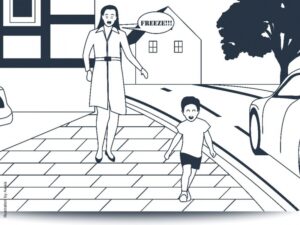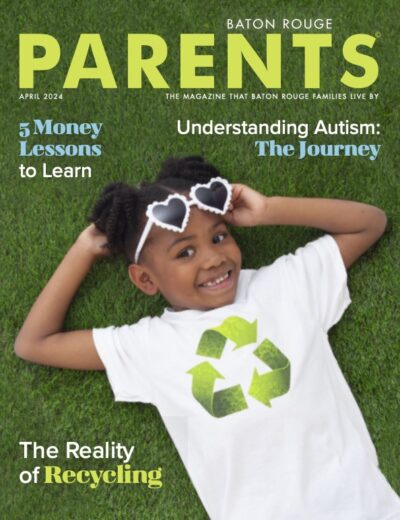
The One Word You Must Teach Your Toddler
You’ve likely been there before. While playing with your busy toddler in your yard, his excitement gets the best of him and off he goes! He’s quickly running toward the street and you’re chasing him after him as fast as you can, which only leads him to think that this is just part of the game, and so, he doesn’t slow down. “Stop!” you yell at him, but he just keeps running. “Freeze!” you yell at him once more, and suddenly, he pauses before he reaches the sidewalk. You quickly catch up to him, scoop him up in your arms, and carry him back inside, your heart beating out of your chest.
This frightening scenario is all too real for many families. Many have had a similar experience that ended without injury, however that’s not the case for some. Pedestrian injury is the third leading cause of accidental death for children ages 5-14.
General Car Safety
Parents often redirect children, and most often, the default term used is ‘Stop.’ However, ‘stop’ can be an overused word and become less alarming for a child in a dangerous situation.
According to Baton Rouge Clinic Pediatrician, Dr. Shelley M. Martin, “Parents can create confusion in young children by overusing the word ‘stop.’” When a young child is running towards the street, yelling ‘stop’ may not be effective, as children may associate this with other, less important times a parent says to stop. For instance, making loud noises in a restaurant; if a child doesn’t immediately stop, he or she is not in immediate danger.
Consider a command that is used specifically for street safety, such as ‘Freeze!’ A command such as this should be taught to children and practiced, so that they understand when they are told to freeze, they know exactly what to do. Whatever is happening at that moment, they must stop completely until further direction from a parent. Additionally, Dr. Martin suggests, “Parents’ tone of voice needs to clearly convey when they are really serious about something.”
Local mom Stacy Roussel Hill stresses car safety using a similar strategy. “Whenever we played in the front yard, I would yell, ‘Car!’ and they knew to sit down immediately.” Over time, her boys began regulating this behavior on their own. Teaching them what to do when they heard the word ‘car’ helped them focus on their surroundings, which is critical for vehicle safety.
Louisiana Pedestrian Laws
Use the Sidewalk. Did you know that it’s illegal to walk in the street when there is an adjacent sidewalk? The sidewalk is always the safest place to walk. In the event there is no sidewalk, pedestrians should use the left shoulder of the roadway.
Obeying Traffic Signals. As a pedestrian, you still have to follow the traffic signals. Pedestrians in Louisiana are legally required to follow and obey every single traffic signal that they encounter.
Intersections and Crosswalks. Louisiana law states that pedestrians have the right of way in marked crosswalks. Vehicles must yield to pedestrians in a marked crosswalk, but pedestrians should always use caution when crossing the street.
Understanding what it takes to safely cross the street is key to why children should not cross the street alone. While each child is different, generally, children under the age of 10 do not have the skills developed to accurately anticipate the speed of an oncoming car and accurately judge the time needed to get across safely. Therefore, children should never cross the street alone.
Local mom Krystal Howell has four young daughters, so safety around cars has always been an organized effort. “When we are all together as a family of six, I say, ‘Everyone grab a buddy!’ and each girl chooses someone.” Howell says that while everyone having a buddy is important, it’s only part of her safety practice. “I’ve taught everyone to always look both ways–look left, look right, then look left again.”
Safety Beyond the Street
Car safety goes beyond crossing the street, and includes driveways and parking lots. According to the Center for Disease Control and Prevention, in the instance of accidents involving toddlers, they are most often struck in the driveway. Preschool aged children are more likely to be hit running in parking lots, and teens are likely to be hit while crossing busy streets.
Accidents can happen anywhere, which is why it is important to have safety measures for all incidents involving moving vehicles. When Krystal is out by herself with her daughters, she instills the same safety measures. “Any time we are near cars, including parking lots, each girl has to be accounted for. When I’m by myself, everyone grabs someone’s hand and we navigate the parking lot together like a conga line, just minus the dancing!”
When Stacy’s boys were young, safety was a priority while getting in and out of the car in parking lots. While strapping the youngest in the car, the oldest waited next to her. “He had to have his hand on the car at all times until I held his hand to walk him around to his side of the car.”
For any type of pedestrian safety, Dr. Martin reminds to families that being a good role model and setting a good example is best for all safety situations. She encourages families to talk about street safety ahead of time, and most importantly, practice. ■





